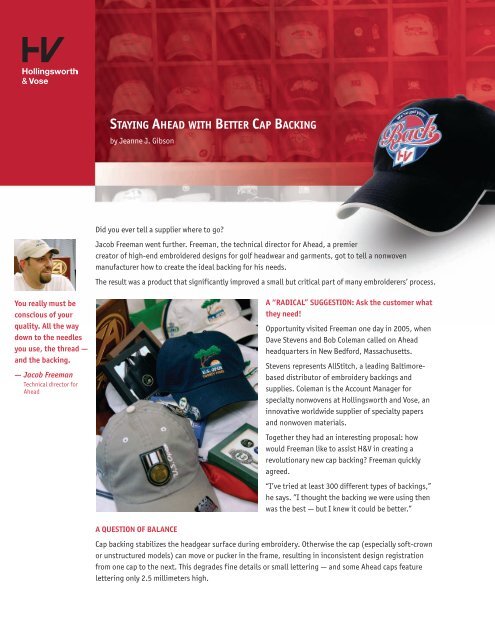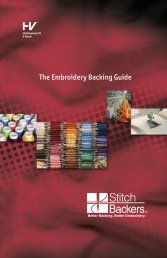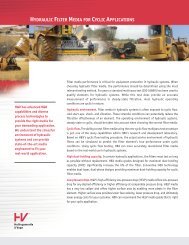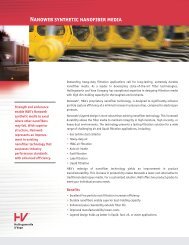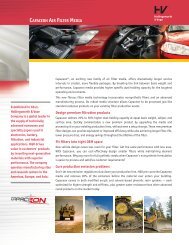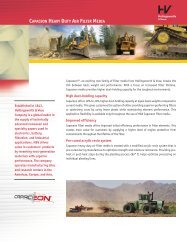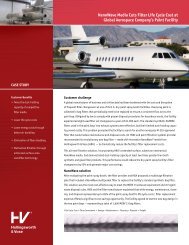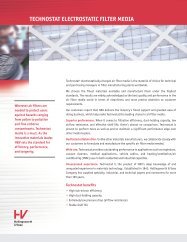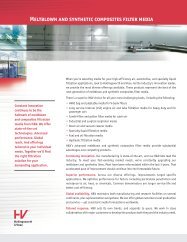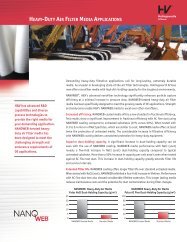staying ahead with better cap backing - Hollingsworth & Vose
staying ahead with better cap backing - Hollingsworth & Vose
staying ahead with better cap backing - Hollingsworth & Vose
Create successful ePaper yourself
Turn your PDF publications into a flip-book with our unique Google optimized e-Paper software.
STAYING AHEAD WITH BETTER CAP BACKING<br />
by Jeanne J. Gibson<br />
Did you ever tell a supplier where to go?<br />
Jacob Freeman went further. Freeman, the technical director for Ahead, a premier<br />
creator of high-end embroidered designs for golf headwear and garments, got to tell a nonwoven<br />
manufacturer how to create the ideal <strong>backing</strong> for his needs.<br />
The result was a product that significantly improved a small but critical part of many embroiderers’ process.<br />
You really must be<br />
conscious of your<br />
quality. All the way<br />
down to the needles<br />
you use, the thread —<br />
and the <strong>backing</strong>.<br />
— Jacob Freeman<br />
Technical director for<br />
Ahead<br />
A “RADICAL” SUGGESTION: Ask the customer what<br />
they need!<br />
Opportunity visited Freeman one day in 2005, when<br />
Dave Stevens and Bob Coleman called on Ahead<br />
headquarters in New Bedford, Massachusetts.<br />
Stevens represents AllStitch, a leading Baltimorebased<br />
distributor of embroidery <strong>backing</strong>s and<br />
supplies. Coleman is the Account Manager for<br />
specialty nonwovens at <strong>Hollingsworth</strong> and <strong>Vose</strong>, an<br />
innovative worldwide supplier of specialty papers<br />
and nonwoven materials.<br />
Together they had an interesting proposal: how<br />
would Freeman like to assist H&V in creating a<br />
revolutionary new <strong>cap</strong> <strong>backing</strong>? Freeman quickly<br />
agreed.<br />
“I’ve tried at least 300 different types of <strong>backing</strong>s,”<br />
he says. ”I thought the <strong>backing</strong> we were using then<br />
was the best — but I knew it could be <strong>better</strong>.”<br />
A QUESTION OF BALANCE<br />
Cap <strong>backing</strong> stabilizes the headgear surface during embroidery. Otherwise the <strong>cap</strong> (especially soft-crown<br />
or unstructured models) can move or pucker in the frame, resulting in inconsistent design registration<br />
from one <strong>cap</strong> to the next. This degrades fine details or small lettering — and some Ahead <strong>cap</strong>s feature<br />
lettering only 2.5 millimeters high.
Stability is also critical for high-stitch-count designs. Ahead produces a number of <strong>cap</strong><br />
designs requiring 10,000 to 20,000 stitches. So a fairly “stiff” product is essential.<br />
But a balanced approach is also vital. With <strong>backing</strong> that’s too tough, operators may struggle<br />
to tear it away cleanly after embroidering, even pulling stitches in the process! And <strong>backing</strong><br />
too light may perforate around high-stitch-count designs.<br />
The <strong>backing</strong> Freeman used before the start of the project had consistency problems from lot<br />
to lot. And far too often, operators were forced to struggle <strong>with</strong> two, three, even four plies<br />
of material to get the required stability, resulting in much wasted production time, effort,<br />
and expense.<br />
Working together, Ahead, AllStitch, and H&V were about to prove they could do much <strong>better</strong>.<br />
A FORMULA FOR SUCCESS<br />
Over the next months, Stevens and Coleman visited Ahead several times, along <strong>with</strong> H&V Senior Scientist<br />
Wai-Ming Choi from the company’s West Groton, Massachusetts, R&D laboratory.<br />
Each time, Choi offered an improved “hand sheet” sample. Stevens and Freeman evaluated it, <strong>with</strong> the<br />
latter personally embroidering a <strong>cap</strong> <strong>with</strong> the trial material. Choi would then use the resulting feedback to<br />
reformulate a new prototype on his lab’s pilot paper machine.<br />
“Fortunately, we already had <strong>backing</strong> formulations to do some of what was needed,” says Choi. “We also<br />
used some technology from H&V’s filtration media. We wound up <strong>with</strong> a cellulose/polyester nonwoven<br />
that met all these demanding performance specs, and could be made at a reasonable cost.”<br />
“Less than a year after the initial meeting — blazingly fast, in nonwoven product development time — the<br />
first sheets of H&V’s StitchBackers Grade 3045 <strong>cap</strong> <strong>backing</strong> rolled off the production line.” says Choi.<br />
Established in 1843,<br />
<strong>Hollingsworth</strong> & <strong>Vose</strong><br />
Company is a global leader<br />
in the supply of technically<br />
advanced industrial<br />
nonwovens. H&V drives<br />
value in customers’<br />
products by inventing nextgeneration<br />
materials <strong>with</strong><br />
superior performance.<br />
H&V’s expertise and<br />
process <strong>cap</strong>abilities<br />
include wet-laid, dry-laid,<br />
meltblown and composite<br />
technologies. The company<br />
operates manufacturing<br />
sites and research centers<br />
in the Americas, Europe<br />
and China.<br />
StitchBackers is a registered<br />
trademark of <strong>Hollingsworth</strong> &<br />
<strong>Vose</strong> Company.<br />
0721015 12/07<br />
A BREAKTHROUGH RESULT<br />
For a distributor, says Dave Stevens of AllStitch, it was an unusually satisfying experience: “In 30 years,<br />
this was the first time I’ve been able to work hand in hand on actual product development from scratch.”<br />
H&V’s Bob Coleman is proud of the result: “There is no other product like it on the market today.”<br />
Ahead’s Jacob Freeman agrees. He’s run nothing but StitchBackers Grade 3045 since August 2006, using<br />
the <strong>backing</strong> on virtually all the company’s headwear products, including high-stitch-count designs, softand<br />
hard-crown <strong>cap</strong>s, low-profile <strong>cap</strong>s, sock hats, and scarves.<br />
He reports significant improvements in stitching uniformity, registration, lettering legibility, and<br />
productivity — especially in the elimination of having to use more than one ply.<br />
“In cost per sheet, this is a little bit higher. But just the fact that we can use one piece — that alone is a<br />
savings for us.”<br />
He sums up why this unusual collaborative effort can benefit embroiderers large and small.<br />
“In this industry, we all know that word of mouth is our best advertising. And so you really must be<br />
conscious of your quality. All the way down to the needles you use, the thread — and the <strong>backing</strong>. Because<br />
the customers that get a great-quality product from you? They’re going to come back.”<br />
Jeanne J. Gibson is the Product Manager at <strong>Hollingsworth</strong> and <strong>Vose</strong>, Inc., for the StitchBackers line of<br />
embroidery <strong>backing</strong>s.


